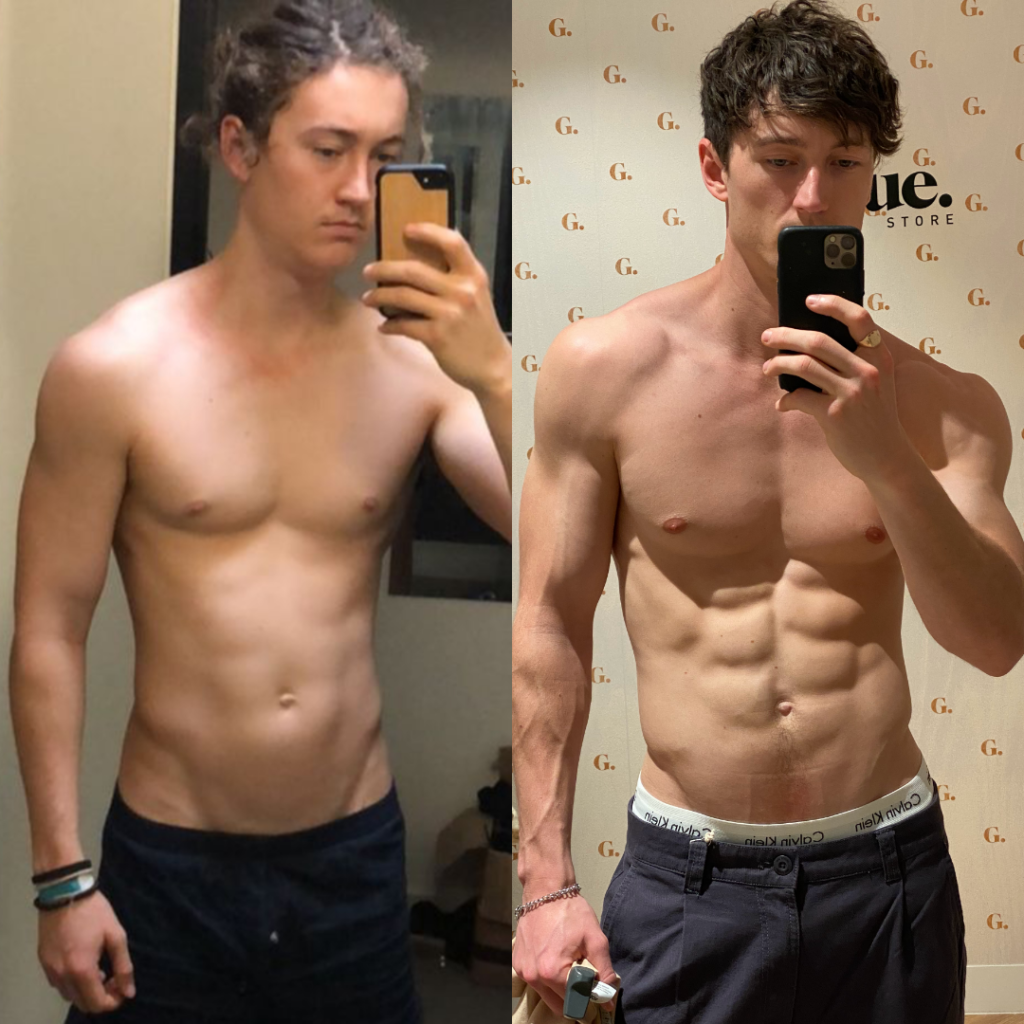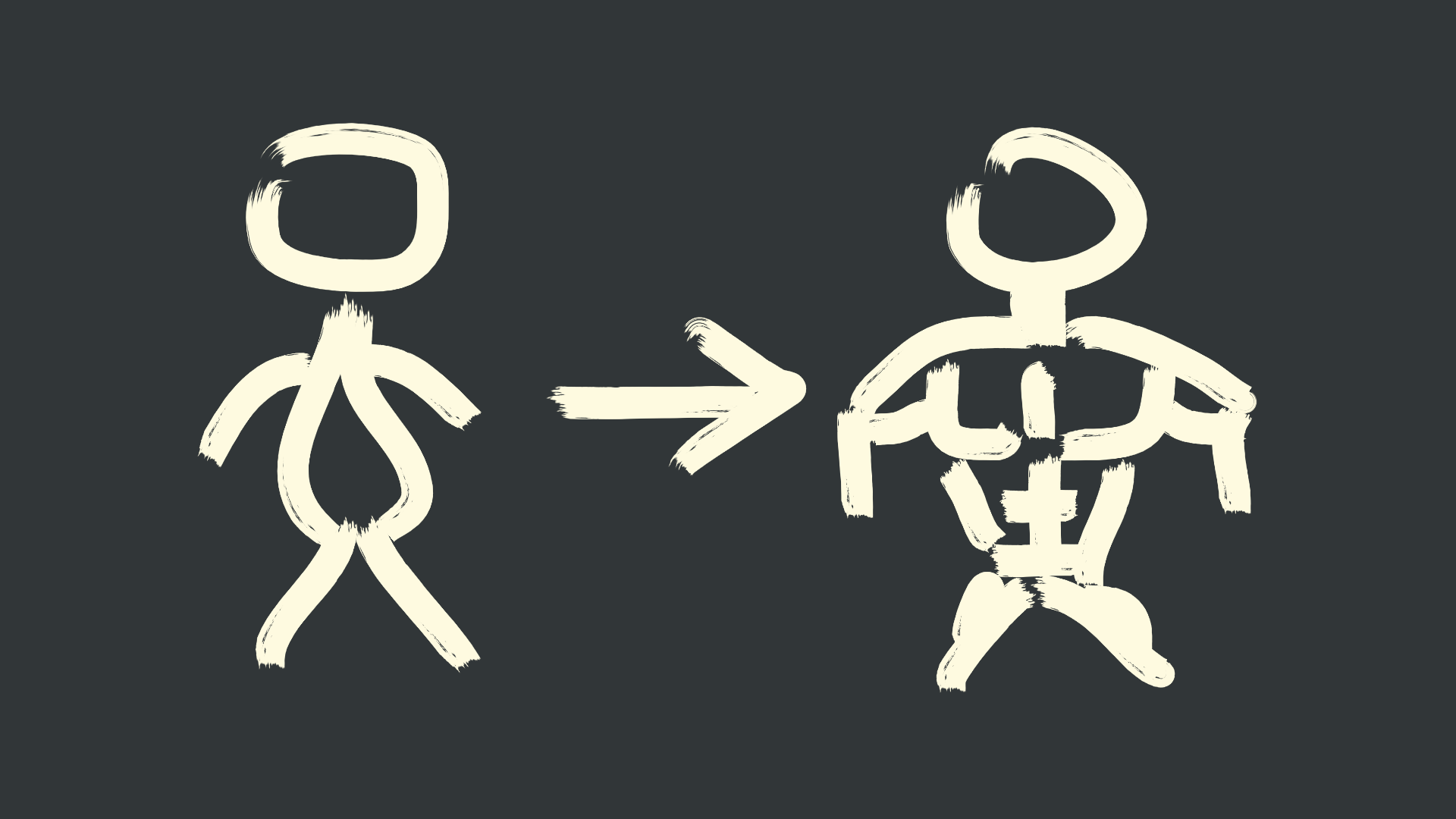People are often shocked when I tell them that my students and I have made transformations like this:

with just:
- 40 minutes a week of training (or less),
- no structured cardio, and
- eating and drinking like kings.
And it makes me realise a fundamental error that we have in our models of how the human body responds to stimuli. If you want to change your physique, you need to understand one basic principle of physiological adaptation:
It’s not about time spent doing. It’s about time spent recovering.
Let that sink in for a second.
The Limiting Factor to Your Progress: Calendar Weeks, Not Hours in the Gym
When making changes to your body, your results do not come from the hours you spend working away in the gym or the kitchen. They come from weeks accumulated while doing these things, consistently. There’s no rule to say these activities actually have to take much time out of your week.
This transformation [pictured above] is a result of simply doing the right stuff (the same stuff I always talk about) for 4.5 years.
It would not matter if I had trained for four times the amount of time per week and been 100% totally perfect with every aspect of my nutrition (which I’m not). My results would look much the same.
Crazy physiques are not a result of doing more. Show me someone who’s achieved that much change in less time without drugs and I’ll be shocked.
Here’s what no one seems to be able to wrap their head around: You can’t speed the process up. You can only make the process happen. Stick to it. And let years pass.
Once you’ve accepted that, then the goal posts move from “How can I blitz my training and nutrition, give it everything, and do as much as possible to ensure I maximise gains?” to “How can I make this process as easy as possible, so that I eliminate all reason to not continue with this for the next 20 years of my life?”
Once training and nutrition become a piss-take in how easy they are, then, counterintuitively, you get the stupid results you’re after. Because now you’ve hacked the real game: behaviour change. Which equates to consistency. Which, as most people are aware of at some level, is how you actually transform.
How I Transformed My Body in 40 Minutes a Week
My results largely come down to what I don’t do. The success of my system has come from how much I’ve been able to eliminate over the years while still getting results. Because that has meant that I (and those I’ve taught) have actually done it, consistently, for these 4.5 years, rather than starting a commitment to 6 days a week of gym sessions and 5 protein-filled meals a day and falling off the wagon two months in because it’s too much. (This is something I see all too often in people with plenty of enthusiasm but no experience.)
Here’s what I’ve done to get the results you see above in 40 minutes a week.
Training
1. Choose ONE strength goal for each major plane of motion.
These need to be heavy. The more strength they require, the more adaptations your body will have to make in order to perform them. That means muscle mass. These will be your guiding light for your foreseeable training career. So lock onto goals you can persist at for the coming 5 years and will require you to be jacked by the time you achieve them.
For me, those goals have been:
- Straddle planche pushup (horizontal pushing)
- Front lever row (horizontal pulling)
- Handstand pushup (vertical pushing)
- One arm chin-up (vertical pulling)
- Single leg squat loaded with 75% bodyweight—for me, 60kg (squatting)
2. Do ONE set per week for each of those movements, working as heavy as possible.
Once a week, I’ll work each of these movements at my maximum strength limit and nothing less, until I’ve had enough (usually a couple of minutes, 1-5 gruelling reps). I focus on increasing this strength limit every time I train, specifically on the first rep (when I’m strongest).
Time taken per week: 30-40 minutes (including rest)
Nutrition
For most people, just training consistently as per above will bring 80% of potential results and change your life in the span of a year or two. Once that habit is in place, the next thing to milk out the remaining 20% will come from dialling in two nutritional factors.
3. Hit a daily protein target.
I aim to consume around 1.8g protein per kilogram of bodyweight per day. This is ample to maximise the available building blocks for muscle growth. So for me this is a daily target of 140g year-round. The way I get this is simply eating 700g of meat a day (100g raw meat has about 20g protein). I’ll get this from 500g of slow-cooked beef or lamb for lunch, then get another 200g chicken or fish or steak (or any other cut) at dinner. You don’t need to space your protein out evenly or be original—keep it simple. Find an easy way to consume your protein on the daily that you enjoy, and just do that on repeat.
4. Hit a calorie target (optional).
This is your final priority and a topic for another article, but the general idea is you just want ample energy available most of the time to allow your body to grow muscle tissue. Then, 12 weeks per year or less, you can switch to an energy deficit—consuming slightly less (20%) calories than you need to maintain your weight—and intentionally force your body to lose some fat. However, for for those starting out, there’s no point complicating things unnecessarily by worrying about this—simply hitting a protein target and listening to your appetite to get enough food in is a very safe strategy. If you eat too much, you’ll just gain plenty of strength, and if you eat too little, you’ll get a bit leaner. As a beginner, there’s no wrong direction you can take as long as you’re training with intent and getting stronger. So until you’re nailing steps 2 and 3, don’t even think about calories.
And that’s it. That’s all I do differently to the average human being that means I now have a visible 6-pack year round while eating more than most people dream of, and strength that lets me move my body in way most will never be able to. Realise that the reason I have these results is because I’ve made my process so simple and easy that there is no reason not to sustain it… so I have.
Lock into a process you can repeat for years, and soon you will wake up wondering why you hadn’t started years earlier. The results you probably want are just a few short years around the corner, and those years are going to pass anyway. How do you want to wake up looking when they do?
